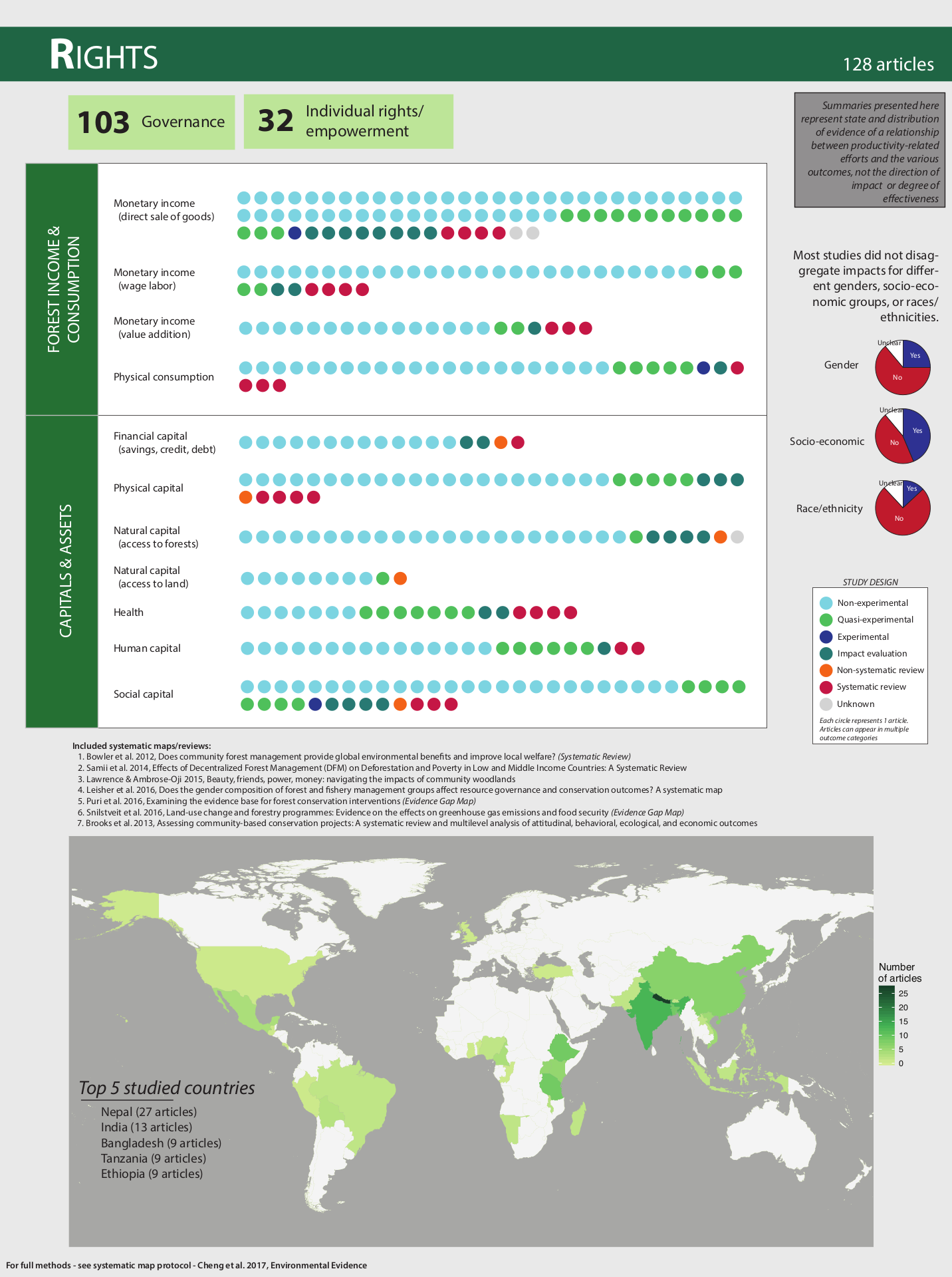Rights – Wealth and agency by strengthening rights over natural capital
Security of tenure and rights over forest resources is important because it can promote investments, increase productivity and contribute to social standing (Meinzen-Dick 2009). Strengthened indigenous and local community rights over forests can contribute to reductions in forest deforestation and degradation (Blackman et al 2017; Chhatre and Agrawal 2009; Robinson 2014; Persha et al 2011; Shyamsundar and Ghate 2014).
- Overview: Strengthening rights over forest resources, including land, products and underground resources, is important to reduce poverty for forest-dependent poor, especially if paired with measures such as developing households’ capacity to engage with markets
- Evidence map: Governance, individual rights and empowerment are the most investigated topics when studying synergies between forest and poverty outcomes
- Country study: Albania – A large-scale government tenure reform program to transfer forest tenure rights to local government units, supported with investments by WB and other donors, helped increase income earned from forest and agricultural activities in communal areas
- World Bank Portfolio Review: A third of the projects in the sample involved strengthening rights, such as granting individuals or communities use rights and strengthening inclusive forest user groups
Overview
Rights over forest resources include individual, household, private sector, community and state rights, and may go beyond rights to forest products to include rights to lease land for gas pipelines, for example, or the right to mine underground resources. Recent experiences emphasize the importance of gathering all stakeholders, e.g. communities, civil society, scientists, and politicians, to find ways to secure tenure and to implement forest tenure reforms to improve households’ welfare. Secured tenure is a powerful instrument to eradicate poverty and ensure human development. In Indonesia, a colloquium gave opportunities to all to share their experience on the ground and to bring out issues such as lack of coordination between government agencies and conflicting maps. The videos below illustrate some highlights from the colloquium.
Globally, 76% of global forests are controlled by governments, with the other 24% managed by communities and the private sector (FAO 2015). The emergence and consolidation of community-based forest management reflects a marked change in forestry in the last two decades. Community control over forests has increased, from 21% in 2002 to 30% in 2013 – a trend that is largely driven by changes in Latin America and China (Rights and Resources Initiative (RRI) 2014).
The effectiveness of such tenure strengthening policies can be undermined by burdensome legal requirements, heterogeneous needs of communities and the costs associated with co-management with the state (Cronkleton et al 2012). Tenure reform can hurt the less-educated poor, particularly if the reform is not cognizant of customary, secondary and informal rights that the poor may have (Meinzen-Dick 2009). Rights and empowerment will translate to livelihood improvements if they are backed with measures that "level the playing field" and develop households' capacity to engage with markets. One such measure may be secondary organizations or federations that can lobby for local communities (Larson et al 2012).
Evidence Map Results
Our knowledge assessment reports that governance, and individual rights and empowerment are the most investigated topics when studying the synergies between forest and poverty outcomes. 128 articles out of the 242 focused on the actions to strength formal and/or informal rights and responsibilities of forest-dependent communities and forest managers such as governance (policies, laws and structures along with monitoring, enforcement, and compliance structures) and individual rights/empowerment (property rights, access, participation at local levels). This assessment highlighted a bulk of evidence on the links between these actions and monetary income through direct sales of forest goods, and social capital.

Back to top
Illustrative Case Study
In Albania, the government embarked on a large-scale tenure reform program to transfer forest tenure rights to local government units. The World Bank, among other donors, supported investments that have helped to support increases in income earned from forest and agricultural activities in communal areas. These investments have also led to significant reductions in erosion, and increases in carbon sequestration. The Albania Story Map below details this program.
Back to top
World Bank Portfolio Review Results
Out of the total number of World Bank projects that met the criteria for inclusion in the portfolio analysis completed under this program (38), 12 (roughly 32%) contained forest rights components as defined by the PRIME framework.These projects worked also on other PRIME elements, showing the synergies and complementarities that exist among the components. For example, eight of the 12 rights projects contained productivity components; 10 had investment components, four markets components and seven also contained ecosystem components. Geographically, the greatest number of forestry projects that contained rights components happen in the Latin American and Caribbean (LAC) and Sub-Saharan African (SSA) regions with three projects each, while the East Asian and Pacific (EAP), and European Central Asian (ECA) regions had two each, and Middle-Eastern and North-African (MENA) and South Asian (SA) regions had 1.
Split by
Color by

